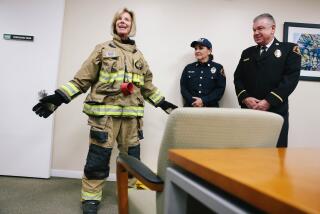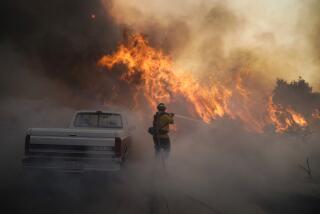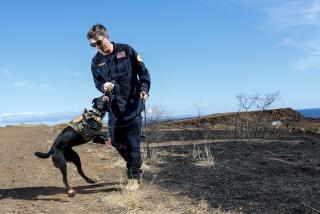For female firefighters at the Thomas fire, there are special challenges
Kelley Whitelens hiked a steep hill toward the backyard of a home on Coyote Road in Santa Barbara, one hand wiping the sweat from her face, the other pulling up her sagging pants.
Whitelens is the only female firefighter in a 19-person team from South Dakota fighting the fierce Thomas fire — which, at 281,620 acres spread across Ventura and Santa Barbara counties, is California’s largest wildfire on record.
It’s unclear how many female firefighters are on the front lines, but with more than 8,000 firefighters battling the blaze at its peak, many include women, who face the same challenges as their male colleagues and one major addition — navigating the heat and treacherous terrain in gear made for men.
“My uniform hangs on me and is baggy,” Whitelens said as she sat down, exhausted, on a wooden bench. “It’s uncomfortable, but I’ve learned to get used to it.”
Whitelens, 21, has been battling wildfires across the country for three years with the Rosebud Sioux Tribe, and it was her eighth day on the Thomas fire line.
Fighting fires runs deep in her family; her brother and nephews are also firefighters. It’s a career she envisions for herself. But there’s one aspect she wishes she could change: her uniform.
Her complaint is not uncommon. Numerous women on the Thomas fire said they have little choice but to wear uniforms that are made for a man’s body.
Rolling up oversized jacket sleeves or pulling up pants so the crotch doesn’t hang below the knee is not merely uncomfortable, but adds another element of danger to front-line duty.
Jessica Hannah, 33, who has been a firefighter with Snohomish County, Wash., for four years, said the mental and physical challenges of the job excite her. There’s been nothing more rewarding than being surrounded by other firefighters battling the Thomas fire who share the same passion and drive to help people, she said.
But as she stood near a booth of donated food late recently at the Ventura County Fairgrounds — the command center for firefighters bucking the fierce blaze — Hannah said she too would obtain a better uniform if she could.
Although her fire department would support Hannah getting customized clothing, she said she is hesitant.
“Our gear is made to last years, so it would be a financial loss for the department.”
Other women on the line said they’ve gotten used to wearing protective gear designed for men.
As Amber Anderson stood with her hands inside the pockets of her blue pants, her blond hair pulled back into a bun, the 36-year-old fire investigator for the Santa Barbara City Fire Department said that although the pants were big on her, she isn’t bothered by the fit and finds the extra legroom comfortable.
“It’s fine. I’ve heard female colleagues talk about it, but I’m used to it,” she said.
Although the number of female firefighters in the United States is growing, it remains a male-dominated industry.
There are around 77,000 female firefighters in the United States, according to the National Fire Protection Assn.
Hannah said she’s “noticed a movement to make more female gear.”
“I’ve heard more women talking about how they want their own gear because of how baggy, heavy and hot the uniforms feel on us,” Hannah said.
For the last six months, Hannah Key, a firefighter with the Sierra National Forest and a fire captain on the Thomas fire, has gathered hundreds of surveys from female firefighters across the nation about their body measurements, firefighter gear and improvements they hope to see.
Her efforts stemmed from an email she sent during the Cascade fire in the spring of 2016 complaining about the lack of fire gear made for women. “Within the hour, I had three people from the company on the phone with me telling me that they’d like to make equipment for women,” Key said.
Since then, Key has been gathering testimonials from female firefighters in California, Oregon, Texas, Florida and other states, gauging their needs and issues they’ve encountered in the field.
“The response has been overwhelming,” Key said. “There’s a market for this.”
Key, 27, has been a firefighter for 10 years.
In some instances, her uniform got in the way of her work out on the field, she said. She often grabs her pants from the waist to avoid tripping when she hikes or crawls over rocks, which slows her down.
During a Yosemite fire in 2010, Key said she fell from a rock after she lost her grip trying to use one hand to hold up her pants and the other to lift herself.
“A lot of profanity was going through my head. I felt very frustrated,” Key said.
While mopping up hot spots in Ojai, Key wore a uniform designed for her body. Her yellow shirt fit snug around her petite frame, and green cotton pants hugged her legs, giving her more mobility and control.
Still, she said improvements could be made.
“The pockets still aren’t in the right place, so when I sit down things fall out,” Key said, “but it’s definitely helped me when I’m out there on the field.”
Follow me on Twitter @melissaetehad
More to Read
Start your day right
Sign up for Essential California for news, features and recommendations from the L.A. Times and beyond in your inbox six days a week.
You may occasionally receive promotional content from the Los Angeles Times.







